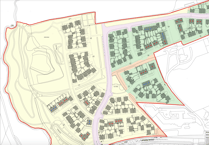THE residents of St Giles-on-the-Heath have been told the choice of a possible site on which to build affordable homes in the village is down to them.
At a meeting of the Parish Council, held in the Coronation Hall annexe and attended by several residents, seven potential sites were presented by Torridge District Council officials.
The sites are Lower Moor; Boxes Shop Field; Dickna Field; the field at the rear of Monterey and Greendale; side of St Giles House; Highfield and finally end of Stanbury Close (Landers Field).
Mr Gavin Spiller, a senior Torridge council planning official, presented the pros and cons for each of the sites.
He and other officials indicated that a need for housing for local people had been identified in the Local Plan, but they told the residents present: "It is very much in the hands of you as a parish."
They added that they were looking at an exception in planning policy in whatever they did. One official described it as "a contentious issue within the village."
Residents raised a number of concerns during the course of the meeting including the speeding of vehicles through the village on the main road, the use of Moorfield Road through the estate for some through traffic, and the capacity of the sewage system to cope with the additional development.
Mr Alan Haddock said: "Speed is one of the biggest problems in the village. I know the police enforce it (the limit) but they can't be here 24 hours a day." He also queried whether empty properties in St Giles could be used for affordable housing.
Another resident said that a projected 70 extra traffic movements via Moorfield Road for some of the sites was "totally out of order."
Mr Spiller said they could chase up the owners of empty properties to find out why they were empty and how long they had been empty but he suspected these would be classed as open market properties not affordable ones.
Maria Bailey, for Torridge, said a small number of open market houses might be allowed in order to make the scheme viable. "It is getting difficult to deliver a 100 per cent pure housing scheme. We do this in consultation with the parish council and the local community. We will not force this on you."
She suggested they get the wider community to comment so they could pick two or three most likely sites and then do a deeper assessment.
"We are in a situation where there is not an awful lot of money locally or nationally. We are looking at the most cost effective way of delivering needs."
She added that Torridge would help them on consultation with the preferred options — possibly via a questionnaire — in order to get a wider view of what was the preferred location. "If you want us to, we can hold an event and go through the detail. We are more than happy to get involved in that."
The parish clerk, Mr Lawless Bethune, said this could be done in the 'Village Connection,' a parish magazine which went to everybody in the village.
The parish council vice-chairman, who presided over the meeting, added that South West Water had said there was enough sewage capacity and they had to take their advice. He summed up by saying they were in a position where they needed — as a village — to look at it with their preferred sites, possibly sooner rather than later, then go back to Torridge with those views and take it forward from there with their advice.
The meeting agreed to proceed along those lines and seek local views on the best site or sites before going back to Torridge District Council. "It is not going to happen overnight," added the vice-chairman.



